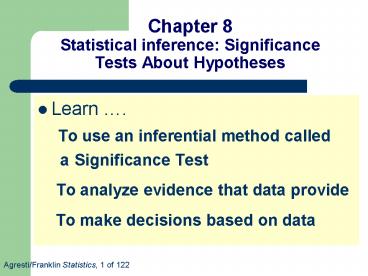Chapter 8 Statistical inference: Significance Tests About Hypotheses - PowerPoint PPT Presentation
Title:
Chapter 8 Statistical inference: Significance Tests About Hypotheses
Description:
Step 1: Assumptions. A (significance) test assumes that the data production ... Assumptions about the shape of the population distribution. Step 2: Hypotheses ... – PowerPoint PPT presentation
Number of Views:114
Avg rating:3.0/5.0
Title: Chapter 8 Statistical inference: Significance Tests About Hypotheses
1
Chapter 8Statistical inference Significance
Tests About Hypotheses
- Learn .
- To use an inferential method called
- a Significance Test
- To analyze evidence that data provide
- To make decisions based on data
2
Two Major Methods for Making Statistical
Inferences about a Population
- Confidence Interval
- Significance Test
3
Questions that Significance Tests Attempt to
Answer
- Does a proposed diet truly result in weight loss,
on the average? - Is there evidence of discrimination against women
in promotion decisions? - Does one advertising method result in better
sales, on the average, than another advertising
method?
4
Section 8.1
- What Are the Steps For Performing a Significance
Test?
5
Hypothesis
- A hypothesis is a statement about a population,
usually of the form that a certain parameter
takes a particular numerical value or falls in a
certain range of values - The main goal in many research studies is to
check whether the data support certain hypotheses
6
Significance Test
- A significance test is a method of using data to
summarize the evidence about a hypothesis - A significance test about a hypothesis has five
steps
7
Step 1 Assumptions
- A (significance) test assumes that the data
production used randomization - Other assumptions may include
- Assumptions about the sample size
- Assumptions about the shape of the population
distribution
8
Step 2 Hypotheses
- Each significance test has two hypotheses
- The null hypothesis is a statement that the
parameter takes a particular value - The alternative hypothesis states that the
parameter falls in some alternative range of
values
9
Null and Alternative Hypotheses
- The value in the null hypothesis usually
represents no effect - The symbol Ho denotes null hypothesis
- The value in the alternative hypothesis usually
represents an effect of some type - The symbol Ha denotes alternative hypothesis
10
Null and Alternative Hypotheses
- A null hypothesis has a single parameter value,
such as Ho p 1/3 - An alternative hypothesis has a range of values
that are alternatives to the one in Ho such as - Ha p ? 1/3 or
- Ha p gt 1/3 or
- Ha p lt 1/3
11
Step 3 Test Statistic
- The parameter to which the hypotheses refer has a
point estimate the sample statistic - A test statistic describes how far that estimate
(the sample statistic) falls from the parameter
value given in the null hypothesis
12
Step 4 P-value
- To interpret a test statistic value, we use a
probability summary of the evidence against the
null hypothesis, Ho - First, we presume that Ho is true
- Next, we consider the sampling distribution from
which the test statistic comes - We summarize how far out in the tail of this
sampling distribution the test statistic falls
13
Step 4 P-value
- We summarize how far out in the tail the test
statistic falls by the tail probability of that
value and values even more extreme - This probability is called a P-value
- The smaller the P-value, the stronger the
evidence is against Ho
14
Step 4 P-value
15
Step 4 P-value
- The P-value is the probability that the test
statistic equals the observed value or a value
even more extreme - It is calculated by presuming that the null
hypothesis H is true
16
Step 5 Conclusion
- The conclusion of a significance test reports the
P-value and interprets what it says about the
question that motivated the test
17
Summary The Five Steps of a Significance Test
- Assumptions
- Hypotheses
- Test Statistic
- P-value
- Conclusion
18
Is the Statement a Null Hypothesis or an
Alternative Hypothesis?
- In Canada, the proportion of adults who favor
legalize gambling is 0.50. - Null Hypothesis
- Alternative Hypothesis
19
Is the Statement a Null Hypothesis or an
Alternative Hypothesis?
- The proportion of all Canadian college students
who are regular smokers is less than 0.24, the
value it was ten years ago. - Null Hypothesis
- Alternative Hypothesis
20
Section 8.4
- Decisions and Types of Errors in Significance
Tests
21
Type I and Type II Errors
- When H0 is true, a Type I Error occurs when H0 is
rejected - When H0 is false, a Type II Error occurs when H0
is not rejected
22
Significance Test Results
23
An Analogy Decision Errors in a Legal Trial
24
P(Type I Error) Significance Level a
- Suppose H0 is true. The probability of rejecting
H0, thereby committing a Type I error, equals the
significance level, a, for the test.
25
P(Type I Error)
- We can control the probability of a Type I error
by our choice of the significance level - The more serious the consequences of a Type I
error, the smaller a should be
26
Type I and Type II Errors
- As P(Type I Error) goes Down, P(Type II Error)
goes Up - The two probabilities are inversely related
27
A significance test about a proportion is
conducted using a significance level of 0.05.
- The test statistic is 2.58. The P-value is 0.01.
If Ho is true, for what probability of a Type I
error was the test designed? - .01
- .05
- 2.58
- .02
28
A significance test about a proportion is
conducted using a significance level of 0.05.
- The test statistic is 2.58. The P-value is 0.01.
If this test resulted in a decision error, what
type of error was it? - Type I
- Type II































